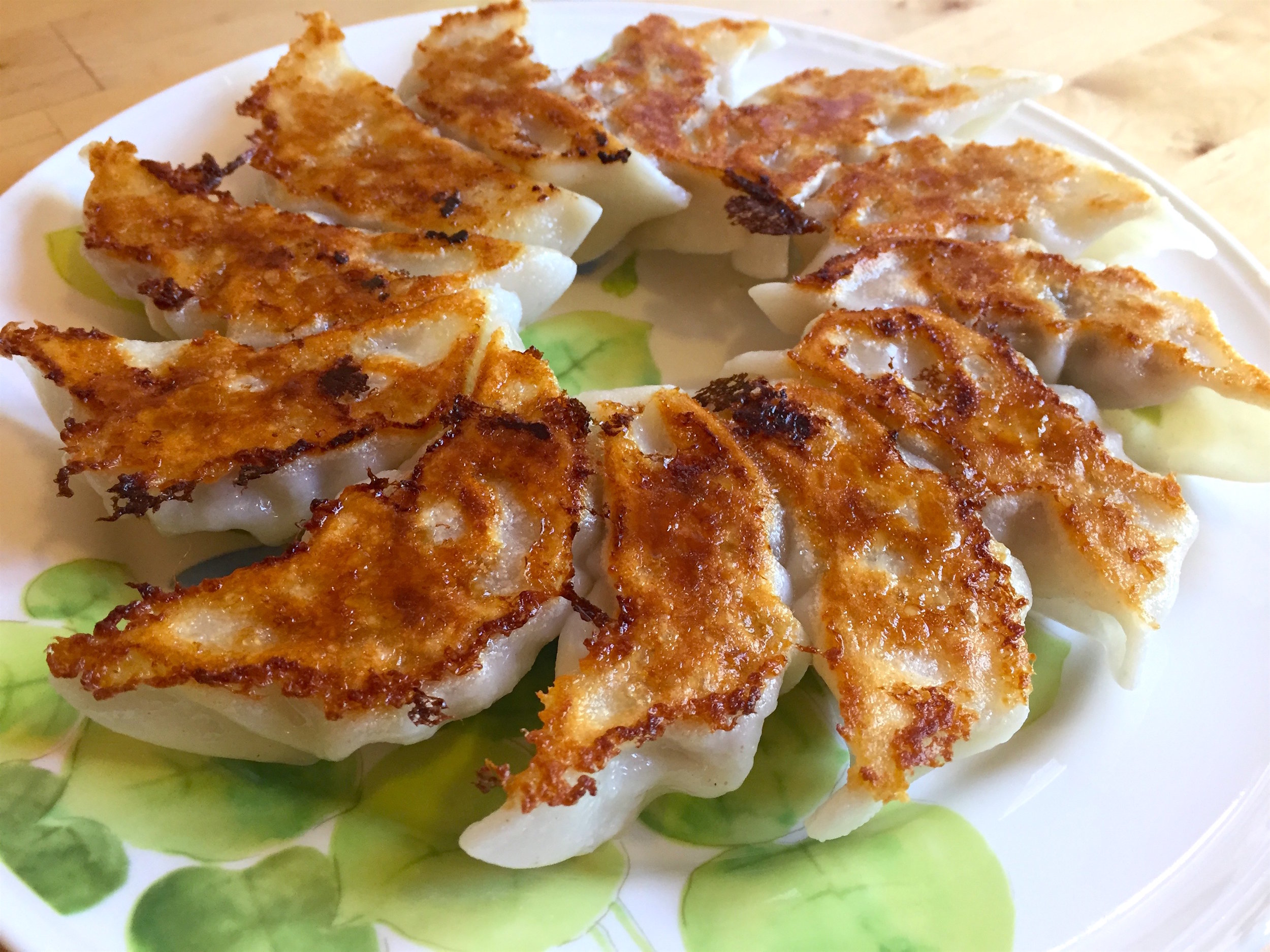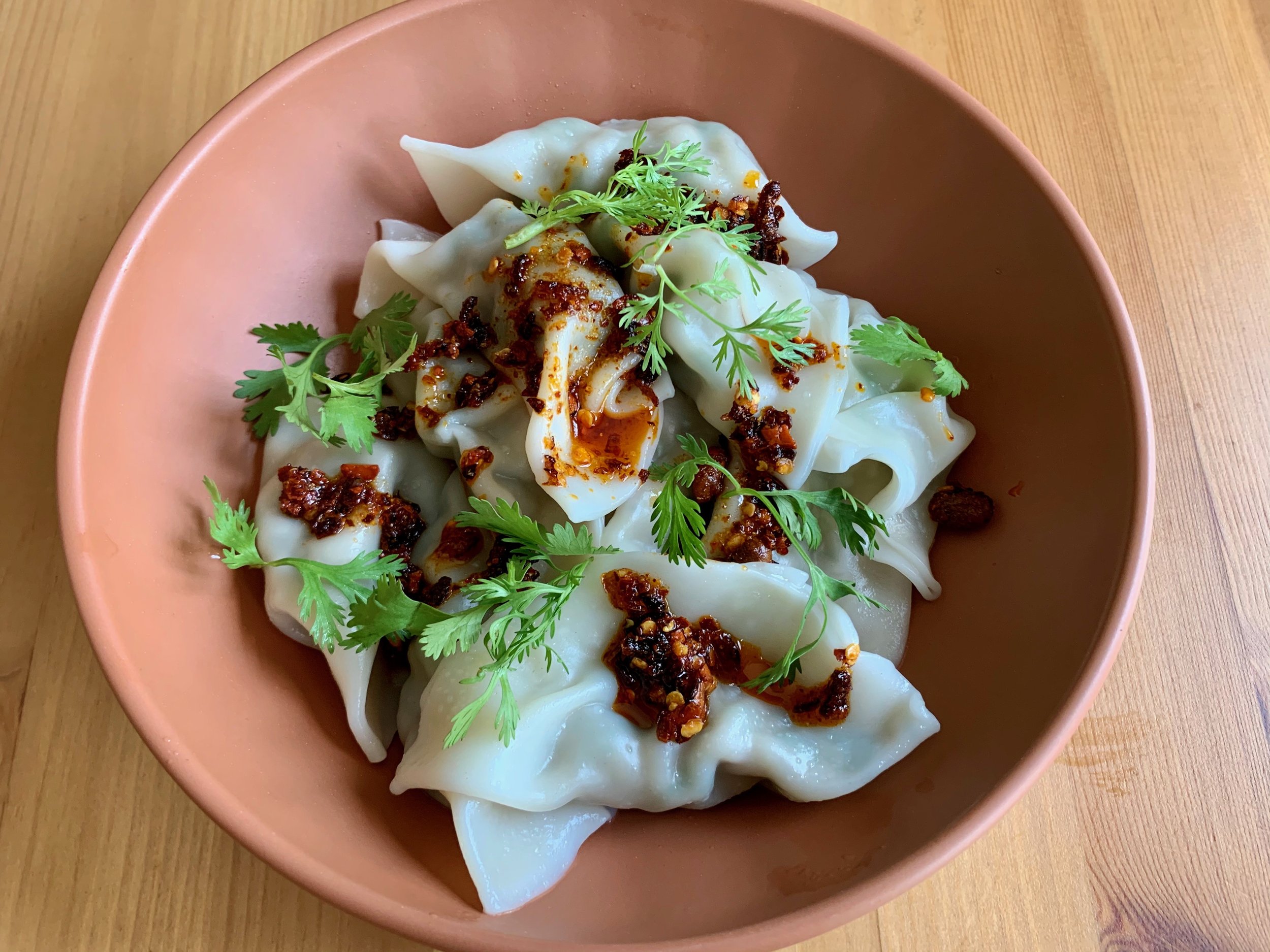Pork and Chive Dumplings

豬肉韭菜水餃
(Zhu Rou Jiu Cai Shui Jiao)
Dumplings are a staple food in Chinese cuisine, found in many forms and with many fillings. Archaeological and historical evidence for dumplings can be found as early as the Han Dynasty.[1] No self-respecting Chinese staple is without an apocryphal origin story, and dumplings have several, featuring frostbitten ears, horns, or the moon.[2] The more likely story, of course, is that early Chinese people, just like every other culture around the world, discovered that there are many benefits to wrapping food in dough—portability, convenience, and increasing the number of meals one could make from a small amount of meat, just to name a few.
Making dumplings at home is cheaper than store-bought dumplings, and gives you greater control over the flavor and quality of the final product. Additionally, they freeze well, giving you a convenient homemade meal if you have made them in advance. Wrapping dumplings together is often a family activity in Chinese households, and it is a great way to spend time with family or friends. They are also commonly served during New Year’s festivities.[3]
Pork and garlic chives is a classic rich and fragrant filling for Chinese dumplings. Today we will be making boiled dumplings, or 水餃.
Ingredients
1½ lb ground pork
1 pkg round dumpling wrappers
12 oz garlic chives, chopped
3 scallions, chopped
1 tbsp cornstarch
1 tbsp soy sauce
2 tsp sesame oil
1 tbsp Shaoxing rice wine (optional)
2 tsp white pepper
½ tsp salt
Garlic chives have a distinct fragrance somewhere between garlic and onion, and pair well with pork.[4] Wash the chives thoroughly, and then finely chop them. We are looking for pieces about ¼ of an inch long. Finely chop the scallions as well, and add the vegetables to a large mixing bowl together with the pork, salt, pepper, soy sauce, sesame oil, rice wine, and cornstarch. Mix thoroughly with a large spoon or clean hands, until the filling is well combined.
At this point you will want to check for seasoning—the best way to do this is to take a small scoop of the filling and microwave it for 30 seconds or so, until it’s fully cooked. Adjust the seasoning to your taste, then prepare to wrap. You can prepare the filling up to two days in advance of wrapping if you wish. Cover tightly and store in the refrigerator.
On a clean table or counter, prepare a workspace for wrapping the dumplings. The dumpling wrappers, if frozen, should be fully thawed. It is important to stop the wrappers from drying out, so depending on how fast you can work, and how humid the air is, it is often a good idea to keep the wrappers covered before wrapping, either with plastic wrap or a clean tea towel. A towel is also useful for drying your fingers. Fetch a small bowl of cold water for sealing the dumplings, and prepare a landing zone for the completed dumplings. If you plan on cooking them all immediately, go ahead and pile the dumplings up on a plate, but if you are planning on freezing the dumplings, prepare a plate, cutting board, or sheet pan covered in plastic wrap or parchment paper. The dumplings should be placed in a single layer with a small amount of distance between them so they freeze individually.
There are a variety of shapes dumplings can be wrapped in, and today we will be creating a simple shape commonly used for 水餃. Remember that a dumpling doesn’t have to be picture perfect to be tasty—as long as the dumplings are tightly sealed and there are no large air bubbles, they will cook up great.
Begin by placing a wrapper in the palm of your hand and scooping about 1 tablespoon of filling into the center of the wrapper. The ideal amount of filling will depend on the size of your wrapper, so adjust this amount as you go. With your other hand, dip a finger in the cold water and run it around the whole perimeter, moistening the edge of the wrapper. This very small amount of water is meant to help the wrapper to stick to itself—it should not be enough to form droplets or run. Dry your finger on the towel, and then pinch the wrapper together at the top. Then bring the two sides of the wrapper together at the top, pressing them together to form an open half-circle. Fold each corner of the half-circle in on itself, and press to seal the corners. Then seal the rest of the edge together, pressing the air out as you go. Finally, twist a single pleat at the top of the half-circle to ensure that the dumpling stays sealed.
When you are done wrapping, if you intend on freezing the dumplings, put your parchment or plastic wrap lined surface into the freezer. After 6 hours or so, the dumplings should be rock solid. Transfer into a zipper storage bag for convenient storage in the freezer.
To Cook
Boiled dumplings (水餃) are the most common home preparation of dumpling, and the simplest to execute. The only big problem to avoid is the dumplings coming apart when cooking. To avoid this, minimize the turbulence in the water by keeping the pot from reaching a rolling boil.
In a large pot, bring water to a boil. When the water is boiling, add the dumplings to the pot, stirring several times to prevent sticking. As with cooking pasta, use a generous amount of water and do not crowd the pot.
When the pot returns to a boil, turn the heat down to a simmer and cook, covered, until the dumplings are fully cooked. This should be approximately 5-8 minutes if you are cooking them fresh, and 15-20 minutes if you are cooking them from frozen. They are done when the skins turn from white to translucent and the meat inside is fully cooked. Generally the pleated seam is the last part of the skin to be fully cooked, and for potstickers of this size, you can be fairly confident that by the time that the seam is fully cooked through, the rest of the dumpling is also cooked.
Remove from the pot with a slotted spoon, and serve with the dipping sauce of your choice. Generally soy sauce based, dipping sauces may also include sesame oil, rice vinegar, chili oil, satay sauce, ginger, and/or garlic. My personal preference when it comes to a dipping sauce for pork and chive dumplings is 3 parts light soy sauce to 1 part sesame oil, with some finely chopped scallions, but I encourage you to experiment.
Substitutions
Ground chicken works well in this recipe in place of ground pork. However, because chicken is very lean, if you use chicken in this recipe you should also add a beaten egg to the mix to help with moisture and binding. Lamb and beef can also be used as dumpling fillings.
Dumpling wrappers can be found either in the fresh noodle section or in the frozen section of most Asian supermarkets. For this recipe, go for the thicker dumpling wrappers, rather than the thinner wonton wrappers. If you can’t find pre-made dumpling wrappers, or just wish to make your own, follow this recipe here.
[1] 206 BCE-220 CE.
[2] The folk story claims that the phrase for dumpling, “jiao zi,” is derived from the phrase for frostbitten ears, “jiao er.”
[3] Dumplings are traditionally part of Chinese New Year feasts because they are a symbol of prosperity—their shape is reminiscent of yuanbao ingots, a form of currency in Imperial China.
[4] Garlic chives (Allium tuberosum) are sometimes referred to as Chinese chives or Chinese leek. Thus, “pork and leek dumplings” often actually contain garlic chives. To add to the confusion, however, some dumplings are actually made with leeks!
Recipe
Prep Time: 1 hr Cook Time: 20 min Total Time: 1 hr 20 min
Difficulty: 3/5
Heat Sources: 1 burner
Equipment: pot
Servings: 40 dumplings
Ingredients
1½ lb ground pork
1 pkg round dumpling wrappers
12 oz garlic chives, chopped
3 scallions, chopped
1 tbsp cornstarch
1 tbsp soy sauce
2 tsp sesame oil
1 tbsp Shaoxing rice wine (optional)
2 tsp white pepper
½ tsp salt
Instructions
1. Finely chop the garlic chives and the scallions. In a large bowl, combine the ground pork, salt, pepper, soy sauce, sesame oil, rice wine, cornstarch, chopped scallions, and chopped chives. Mix the filling until well-combined.
2. To begin assembly, prepare a small bowl of water, and unwrap the dumpling wrappers, keeping them under plastic wrap or a clean tea towel.
3. To wrap, begin with a single wrapper in your hand. Spoon approximately 1 tablespoon of filling in the center of the wrapper, and moisten the edge of the wrapper with water using the tip of your finger. Seal the wrapper, forming the dumpling into the proper shape.
4. Once all the dumplings are wrapped, cook immediately, or freeze.
To Cook
1. Bring a large pot of water to a boil, and add dumplings to the water.
2. When the pot returns to a boil, reduce the heat and simmer until fully cooked—approximately 8 minutes fresh, or 15-20 minutes frozen.
3. Remove from the pot with a slotted spoon and serve.

















